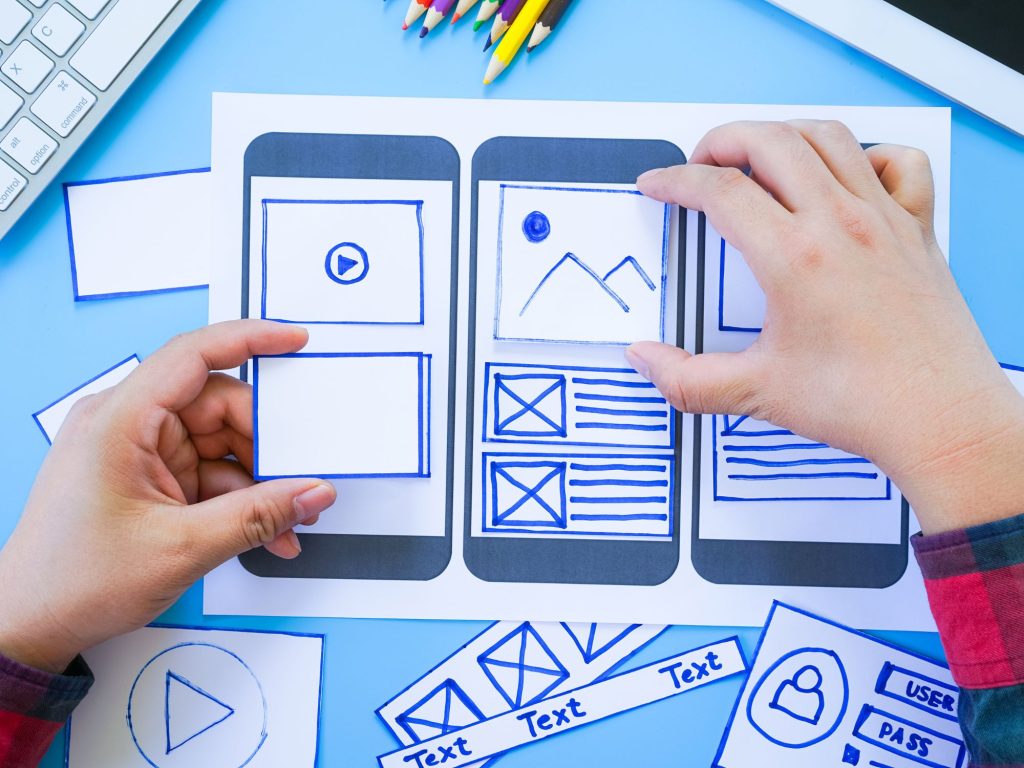
Landing pages are specialized pages that businesses use to drive conversions and get visitors to take a specific action. We’ve all encountered them – you click on an ad or link and get directed to a page solely focused on getting you to buy something, subscribe to a newsletter, attend a webinar, etc.
While most websites have pages with navigation menus and multiple options, landing pages are stripped down with laser focus on one goal. They allow marketers to guide users through one particular funnel or conversion path.

Now you may be wondering – what makes landing pages so crucial for digital marketing compared to regular website pages? There’s a few key reasons:
So in summary, dedicated landing pages are essential because they allow you to laser-target your messaging and offers, reduce distractions, and ultimately drive more conversions and ROI from your digital marketing campaigns.
Previously, we discussed on the psychology of landing pages. And as we’ll explore, they are evolving in exciting ways. As part of our landing page introduction – please continue to read as we discuss the future of landing pages.
Landing pages have become a standard part of digital marketing strategies today. The typical approach is to create a standalone landing page for each distinct campaign, promotion or funnel. For example, a company might have unique landing pages for its email nurturing program, webinar registrations, ebook downloads, free trials, etc.
The overall design and messaging aims to quickly communicate with visitors and guide them towards conversion.
This approach has proven successful to capture leads and increase conversion rates compared to sending traffic to generic website pages. However, there are some drawbacks. Managing numerous one-off landing pages can be labor intensive. Content quickly becomes outdated and irrelevant. There’s often little personalization or dynamic content.
While current practices emphasize simplification, some pages end up too simple and generic. Finding the right balance of targeted messaging without oversimplification is an ongoing challenge. Still, well-designed and aligned landing pages are a staple of digital marketing. Marketers are now looking to evolve tactics to the next level.
Landing page design and style continues to evolve as marketers balance aesthetics, user experience, and conversion performance. Some emerging trends include:
Minimalism Taken Further – Landing pages are embracing even more stripped-down, simplified designs. Negative space, clean fonts, and absence of distracting elements create focus.
Mobile-First Design – With growing mobile traffic, landing pages are optimizing for smartphones and responsive designs as the primary experience, rather than an afterthought.
Long-Scrolling Pages – Longer scrolling pages with minimal page breaks are popular, allowing users to digest info at their own pace.
Prominent Multimedia – Relevant images, illustrations, and video are increasingly important, especially hero banners and visuals showing products or services.
Bright, Vibrant Colors – Branding with bold, inviting colors helps pages stand out. But colors need to align with brand identity.
Custom Illustrations – Unique flat, isometric, or line-style illustrations differentiate from stock photos and communicate brand personality.
Typography as Design – Font selection, scale, and layout add visual impact and personality that enhances the user experience.
Conversational Tone – Friendlier, conversational language and tone reflects how people speak versus overly salesy or formal text.
Overall, landing page design is focusing more on visual appeal and aligning with brand image while retaining a conversion-focused structure. Standing out requires landing pages to be highly engaging and reflective of the brand’s style.
One huge shift we’re seeing with landing pages is using customer data to create more personalized, tailored experiences. Generic “one-size-fits-all” landing pages just aren’t cutting it anymore. People expect more relevant content catered to their needs.
Thankfully, marketers now have the technology to dynamically customize landing pages for individual visitors. So instead of showing every person the same generic page, you can showcase unique content, offers, and messaging for specific segments and interests.
For example, say you sell software. When a visitor arrives at your landing page, the technology can detect if they are in the healthcare industry based on their company IP address. You can then dynamically display case studies, testimonials, and messaging specific to healthcare roles they would relate to.
Or the page can display different content for newcomers versus existing customers. The possibilities are endless once you can tap into data to modify page visuals, copy, testimonials, case studies, and more on-the-fly.
AI and machine learning also come into play here. Intelligent algorithms can analyze customer interests and behavior to predict what content and offers will resonate best with each individual. Landing pages change in real-time to reflect those predictions. It’s next level personalization!
The benefit of all this? Greater relevance, engagement, and ultimately conversions. When you speak directly to people’s needs and interests, they pay attention and buy into your solution. One-to-one personalization is the name of the game these days!
Video is becoming an increasingly important element of landing page design. According to studies, including video on landing pages can boost conversion rates by over 80% in some cases!
The key is making videos short, impactful and relevant to the offer or CTA. Videos help engage visitors in a multi-sensory experience. They also boost SEO if hosted natively on the page.
With faster internet speeds and greater video marketing adoption, expect to see video become an integral element of high-converting landing pages. Don’t let your static pages get left behind! Give visitors a taste of what your brand offers through the power of sight, sound and motion.
The most important element of any landing page is the call-to-action (CTA). This is the specific action you want visitors to take, like “Sign Up Now”, “Start Free Trial”, “Buy Now”, etc.
With continual optimization of copy, design, timing and placement, CTAs can drive higher conversions, revenue, and ROI from landing pages. They are the linchpin that activates your target response.
Chatbots are emerging as an impactful addition to landing pages. Chatbots are AI-powered bots that can have conversational interactions with website visitors. When integrated directly on landing pages, they can engage visitors to help qualify leads and guide them to conversion.
Key considerations are making chatbots align to brand identity and tone of voice, ensuring AI conversations are natural, and providing an opt-out to live chat if desired.
With chatbots able to have meaningful interactions at scale, they create more human-centric landing page experiences that make visitors feel valued, understood, and attended to. This drives more conversions and sales pipeline success.
Beyond just text, graphics, and video, adding interactive elements to landing pages is an emerging trend to boost engagement. When visitors can actively participate on the page, they become more immersed in the experience.
The interactive components relate directly to your offerings, allowing visitors to experience them first-hand on the landing page. This makes the value more tangible before needing to convert.
When visitors shift from passive to active engagement, pages become more memorable, informative, and effective. Interactivity turns landing pages into an immersive storefront experience that drives more conversions.
To maximize landing page effectiveness, continual testing and optimization is essential. There are two core methods to test and improve landing pages:
In addition to testing, studying visitor behavior provides optimization insights:
Ongoing experimentation, data analysis, and incremental improvements ensure landing pages stay highly optimized based on real visitor actions. Testing and tweaking is the best practice for continuous optimization.
To fully understand landing page performance, marketers are enhancing their analytics capabilities and attribution modeling.
Expanded analytics provide greater visibility into:
This end-to-end data across channels and devices paints a complete picture of the customer journey. Marketers can better evaluate landing page ROI when connecting engagement to downstream conversions.
Improved attribution also gives proper landing page credit. Rather than last-click or first-click models, advanced attribution allocates credit across all touchpoints influencing conversions.
Machine learning models can analyze huge volumes of data to uncover the combinations of factors that most impact revenue. This gives accurate multi-channel credit to landing pages for their contribution to sales.
With clearer attribution and holistic data, marketers move beyond siloed landing page views to truly understand their crossover impact on real business results. The future is using that insight to strategically improve landing page alignment across the customer journey.

One emerging innovation we will see more of is using machine learning and AI to predict customer needs, interests, and behavior for personalized landing pages.
Predictive analytics analyzes multiple data points like:
Advanced algorithms process these signals to infer visitors’ needs and likely interests based on statistical models. The landing page experience adapts in real-time based on each prediction.
For example, predicting the visitor has high commercial buying power would trigger messaging about enterprise-level capabilities. Searching for case studies may serve up specific vertical-relevant examples.
The goal is to surprise and delight each prospect with relevant content and offers tailored to their implicit needs identified by the model. No more one-size-fits-all!
Predictive personalization takes customization to the next level beyond just observed behaviors. The technology continually gets smarter in understanding customers and serving up the right experience for each individual.
The future is leveraging predictive intelligence to make landing pages feel like a helpful assistant giving you exactly what you want before you even ask. Hyper-customized sites that predict your needs – that’s the next wave of effective landing pages.
In the past, landing pages were often created in isolation for individual campaigns and offers. But the future of landing pages involves deeper integration across channels and the entire customer journey.
With this cross-channel integration, landing pages become a more strategic part of the entire customer experience across touchpoints and platforms. The experience feels more seamless and connected vs disjointed.
Marketers can nurture visitors with relevant messaging as they progress through the funnel. Stronger attribution also demonstrates true landing page ROI throughout the customer lifecycle. The future is creating aligned cross-channel experiences.
Artificial intelligence (AI) is transforming marketing technology, and landing pages are no exception. Here are some ways AI can elevate landing page effectiveness:
The applications of AI are vast when it comes to understanding customers, experimenting, personalizing, automating, and optimizing landing pages at scale. AI takes data-driven marketing to the next level.

The technology landscape for building and optimizing landing pages also continues to evolve. Some notable innovations include:
Marketers now have more technology choice than ever to build landing pages tailored to brand needs at higher degrees of personalization, automation and optimization. The key is choosing platforms that align to experience and conversion goals.
Looking ahead, landing pages will continue to evolve as part of providing cohesive cross-channel customer experiences. Some predictions for the future include:
The future of landing page design lies in crafting responsive, omnichannel experiences that evolve with the customer through their journey – not just one-off static pages. The page is just one step in an interconnected process driving conversions and customer loyalty.
Landing pages have become a vital part of digital marketing strategies, optimized to drive conversions and customer actions through focused messaging and experience design.
As we have explored, current best practices are evolving across many dimensions – from personalization to integrations, video to interactivity, and AI-driven optimization.
Key themes point to more dynamic, customized experiences based on data and testing. Tighter coordination with customer journeys before and after the landing page is also critical for impact.
Marketers must balance creativity with performance analysis to craft experiences that are both resonant and results-driven.
While landing pages will always be a key conversion channel, they are transforming to deliver value throughout the customer lifecycle. The future is using landing pages as part of an omnichannel ecosystem tailored to customer needs, not isolated destinations.
By continually experimenting, listening to data and optimizing around visitor behaviors, landing pages will rise to the next level in driving business success. The customer experience is now the product marketers offer – and refined, personalized landing pages are an integral part of shaping positive customer journeys.
Where Creativity Meets Simplicity - Customize with Ease! Forget about Coding and Enjoy Designing Your Website.